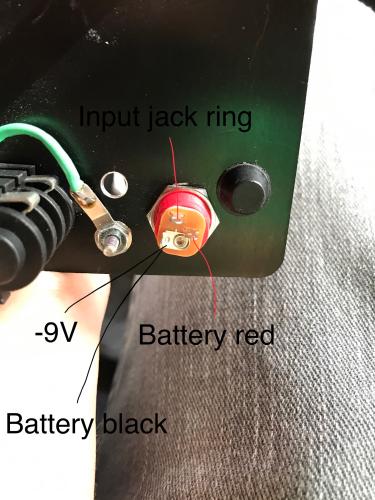First time wiring a pos ground effect...Help!!
First time wiring a pos ground effect...Help!!
|
Hello all,
First off thanks for all the great work and resource. It is much appreciated. I have never wired a pos ground effect. I have always used an inverter. Have not gotten the results I've wanted from them so I'm going to try just using a battery. My question is when wiring offboard. Is it the same as what's posted on the site? Also, just to be clear. When connecting battery to effect the - terminal goes to red and pos goes to black? Just want to make sure...lol! Feel like an idiot asking this but darn if it is confusing. Anyways, halve a great one and thnx again!!! |
|
Administrator
|
yep, you got it. basically ground and positive are flipped. never feel like an idiot for asking something, cause that's how you're going to learn. trust me i've asked some of the silliest questions when i started building.
|
Re: First time wiring a pos ground effect...Help!!
|
Thnx rocket that means a lot! So, everything stays the same on the offboard wiring? Just change the polarity of the battery connection going into effect?
|
|
Administrator
|
if it's a PNP (positive ground) build to begin with yea. if it's a NPN (negative ground) build that you're making into PNP all the polarized parts (electrolytic caps & diodes) get flipped as well.
|
Re: First time wiring a pos ground effect...Help!!
|
Awesome thnx rocket:))
|
|
Perhaps its just me but I can never understand why these are referred to as positive ground, probably should be called negative supply effects as ground is never positive or negative by definition...
|
Re: First time wiring a pos ground effect...Help!!
|
I highly prefer the use of the 7660 based voltage inverter so you can daisy chain. It's such a small board to add and it works great.
|
|
Administrator
|
In reply to this post by scimitar
the reason why circuits are referred to by ground, at least as far as i understand, is that voltage has a positive and negative, and ground determines the polarity. so if ground is the positive side it's a positive ground effect, and if ground is negative it's negative ground. so PNP is positive ground, NPN is negative ground. i could be completely wrong, but that's how it was explained to me years ago. |
|
In reply to this post by scimitar
I don't have a problem with the term 'positive ground'. Your power supply provides you with two leads that are a fixed voltage apart. There's a positive one and a negative one, but until one of them is attached to some reference voltage, their absolute values are free to float. There's only one fixed reference voltage in the entire guitar/pedals/amp chain: the ground provided by the mains. It has a direct DC connection through the amplifier and your signal chain, all the way to your pickups. An obvious question is 'How does this circuit connect to the only reference voltage we have access to? Is perhaps, as is often the case, one of the DC rails attached to it? If so, which one?' This is necessary information when you are designing a circuit or drawing a schematic. 'Positive ground' answers that question directly, 'negative supply' doesn't. Technical terms are just names. They don't have to be decipherable at first glance. (We just packed the entire above paragraph into two words, so...) It's better that they easily convey useful technical information efficiently once you know them. |
Re: First time wiring a pos ground effect...Help!!
|
In reply to this post by BetterOffShred
Ya, I've always used the inverter. I want to use a battery to rid myself of another element. I still haven't gotten pnp ge effects to sound the way I want. Buggers!!!
|
Re: First time wiring a pos ground effect...Help!!
|
I'm embarrassed to admit it, but I'm still a little confused about this. I've built over 40 pedals but they've all been npn, now I have some gt402v and lT308b's and wanna branch out into the wide world of germanium. If I'm using a dc jack and no battery, does -9v go to where ground normally would on the dc jack and "+" ground goes to where +9v normally would on the dc jack? Or am I totally stupid in thinking that? Cant seem to Google an image that shows me what to do. I understand why you can't daisy chain, it's just the wiring that has been confusing me. Also, does the + of the led now go to the footswitch and - to the dc jack. Sorry, I feel dumb.
|
Re: First time wiring a pos ground effect...Help!!
|
What I did was reverse the polarity on the effect. So, my pos red, normal polarity, goes to the pos black, and the normal neg black goes to neg red on effect. When I got to offboard wiring. I just wired the effect normally.
|
|
Administrator
|
In reply to this post by Mulekicker
No need to feel dumb at all.
I made a quick little image of how I do battery + dc jack for positive ground 
|
Re: First time wiring a pos ground effect...Help!!
|
That's what I needed, thanks!
|
«
Return to Open Chat
|
1 view|%1 views
| Free forum by Nabble | Edit this page |

